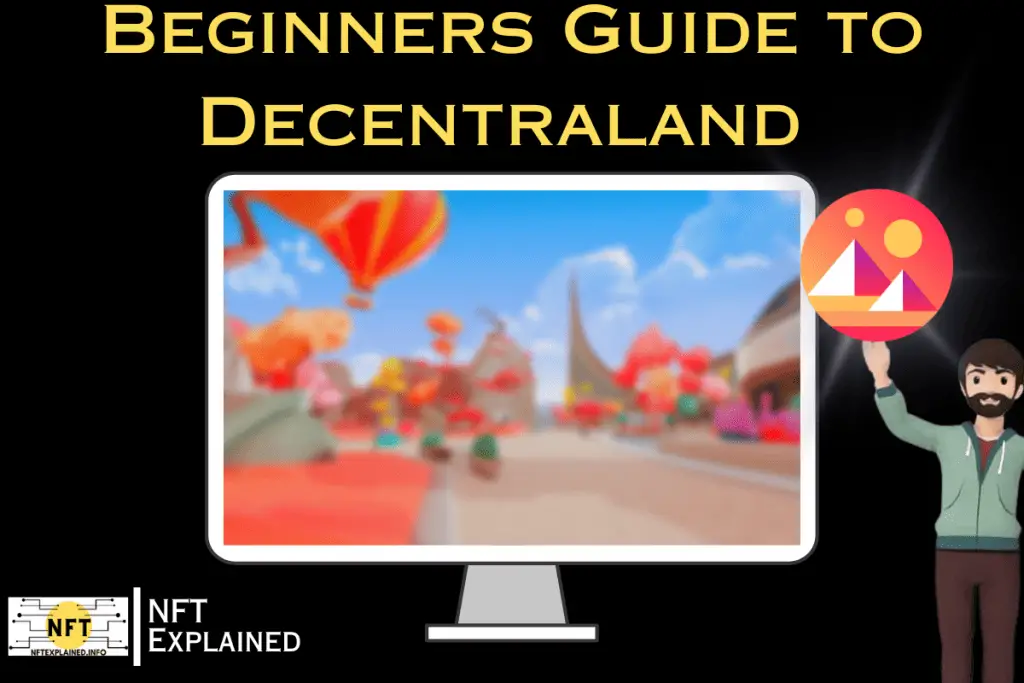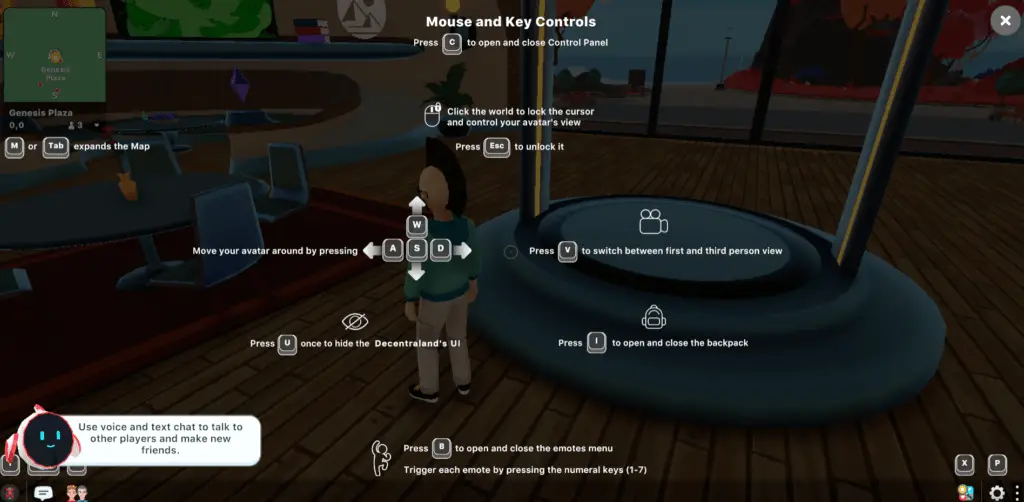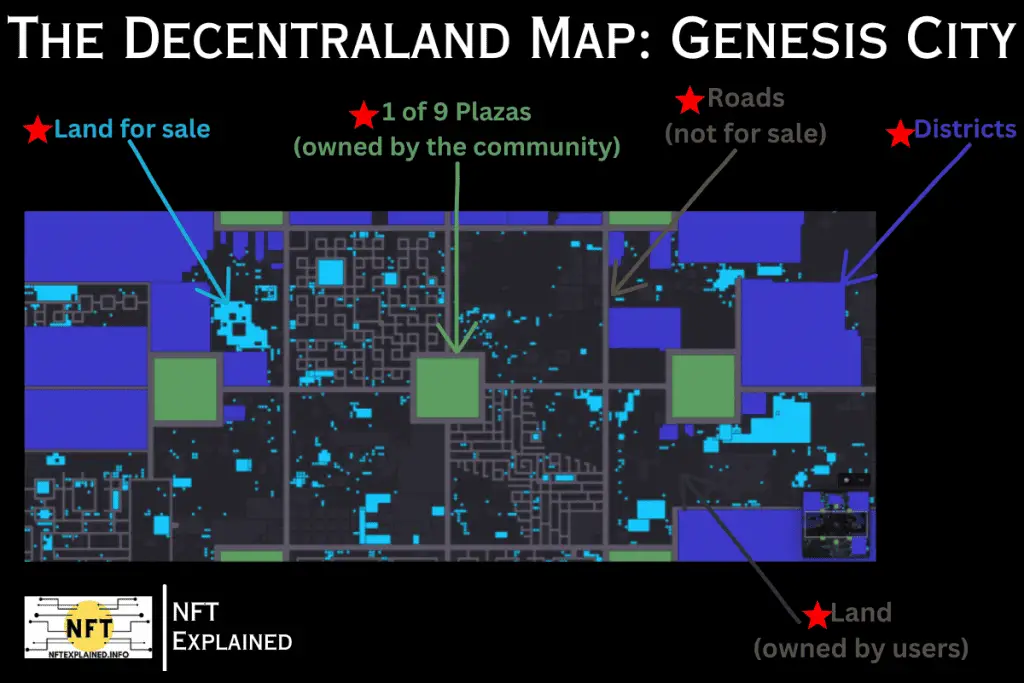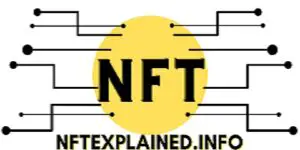
The rise of NFTs and the concept of the metaverse has brought awareness to Decentraland – one of the first blockchain based games. With plots of digital land selling for as much as $913,500 USD, it is no surprise that attention has been brought to the game and its highly speculative investors.
As a seasoned explorer of Decentraland and other metaverse games like The Sandbox, I’m here to be your guide. I will explain the unique features the game offers and provide my honest opinions. Before we get into that, what is Decentraland?
Decentraland is a blockchain-based game where users can own in-game assets like avatars and land as they’re NFTs. It operates on the Ethereum and Matic blockchians, enabling seamless interoperability. MANA, the native cryptocurrency, empowers voting in the Decentraland DAO and facilitates transactions.
I personally think Decentraland is making a big leap within the gaming space through utilizing NFTs – as players can actually own in-game assets.
By having the game utilize NFTs, the ability to resell these items on third party marketplaces like OpenSea are present; this undoubtedly gives more power to the player, and I think it’s a positive step in the gaming space.
Even the land in Decentraland holds its own uniqueness as NFTs, which therefore creates inherent value, similar to the real estate market in the real world. Parcel owners (aka land owners) possess the creative freedom to design buildings on their land through a user-friendly drag-and-drop editor; this makes different sections of the world very unique.
However, it’s worth noting that Decentraland does have its limitations. Due to the user-driven nature of the platform, not all land plots are meticulously designed, which can occasionally result in pockets of barrenness within the virtual world.
Before I mention where these NFTs or digital assets are stored, it’s important to note that users don’t have to connect their blockchain wallet in order to play the game. It’s possible to simply play as a guest where your information will be stored locally.
That being said, playing as a guest does heavily limit your experience as many features won’t be available. If you do connect a blockchain wallet, you will interact with the Ethereum or Matic blockchain which is where the NFTs will be stored.
Both blockchains are interoperable with one another, meaning transactions reflected on one blockchain will eventually be reflected in the other. As a user, you can choose which blockchain you would like to transact with.
I will note that Matic was added as a cheaper and faster alternative to Ethereum. In addition to partnering with Decentrland, Matic has partnered with Disney, Starbucks, and numerous firms within the financial sector.
Decentraland takes their blockchain use a step further with their native cryptocurrency $MANA which allows you to participate in the Decentraland DAO; the DAO allows you to vote on changes within the game. How the games’ DAO works is beyond the scope of this article but is explained thoroughly here.
Aside from giving the user voting rights in the DAO, MANA also facilitates transactions such as the buying and selling of virtual goods. MANA can also be earned through play-to-earn games and other methods, like gambling, within the virtual world.
In the subsequent sections, I will delve into each of these aspects in greater detail, as they possess inherent uniqueness within the realm of blockchain games. Before that, I will provide a comprehensive overview of my opinions on the game, setting the stage for a deeper exploration of these captivating features.
Decentraland: A Comprehensive Review and Analysis
Decentraland provides unique features found only in blockchain games (e.g. leveraging NFTs for verifiable user ownership). However, graphics and loading speed may not meet gamers’ expectations. With a DAO, NFTs, and a metaverse model, Decentraland stands out as a unique experience – one you should explore yourself.
I will provide more of my subjective feedback starting from the beginning phases of the game.
When taken to the official Decentraland page, new members are prompted to begin exploring. Users can either sign in via a blockchain wallet, through Fortmatic which allows you to use an email account, and by playing as a guest (requiring no input of information).
If you login using a blockchain wallet, you have the opportunity to create your own avatar which I would describe as being akin to creating a Bitmoji for Snapchat; subsequent to this, you enter a name for your avatar and a valid email address.
Now, welcome to Genesis Plaza, the vibrant heart of the Decentraland universe, where characters navigate using familiar gaming controls (W, A, S, D) and can change views with a simple press of ‘V’. With a user interface reminiscent of most games (e.g. Fortnite), those acquainted with its gameplay will have no trouble navigating around.

I would recommend staying within the plazas (green areas) where there is much to explore especially considering that other locations on the map may be empty parcels (which can be mundane).
Moreover the game offers a talking feature in which nearby users can engage in conversation via text (and a voice chat). I did in fact discover a community of helpful individuals offering valuable advice on exploration. This challenges the common perception that the metaverse is filled with uncivil behavior; however, I am sure each experience is different.
Another cool aspect was checking out the Decentraland marketplace where wearables, emotes, land, and names were being sold – some of which were surprisingly being sold for reasonable prices.
Decentraland’s graphics and web-based application loading speed may fall short of the quality level expected by users, particularly those who are well-versed in the gaming world. Although these aspects can be frustrating, Decentraland compensates for it by having unique features like the ability to explore land developed by other players. I’ll further explore some of the other options players have within the virtual world.
What Can You Do in Decentraland? Exploring The Possibilities
The metaverse is completely free for users to hop into; however, additional features and applications often need MANA, the game’s native ERC-20 token.
In Decentraland, users can create avatars, explore, play free games, socialize, and engage in the economy using MANA. Holding MANA allows users to create/vote on proposals to change the game via the Decentraland DAO, buy land or purchase other NFT items, gamble, and even establish a business.
A major attraction in the metaverse is creating a game or business in which the creator will receive MANA for users participation. Another attraction is creating wearables to be sold on the marketplace. This monetization process where MANA is received can be cashed out for fiat currencies; it may even be lucrative, depending on your creation skills.
I think the monetization aspect draws in a lot of users who eventually become creators; this is something I will further explore in the next section. Overall, there are many features to investigate and I was pleasantly surprised to see new aspects in the game – after testing it out again – several months after my first experience.
Can You Make Money on Decentraland? Exploring Profit Potential
Surprisingly, the metaverse world of Decentraland offers a multitude of avenues to turn a profit.
Decentraland offers profit opportunities through NFT reselling of: parcels, estates, wearables, and avatar names. Users can also establish in-game businesses, create wearables to sell on the marketplace, engage in gambling within the virtual world, and even invest in MANA for potential price appreciation.
With that being said, always complete your own due diligence before deciding to purchase anything. I am in no way providing any financial advice and investing in any blockchain based asset carries inherent risk.
The most profitable, expensive, and therefore the most risky is the buying and selling of land as there is a limited amount. There are numerous large companies who own land within Decentraland including Atari and Samsung; there are other large companies who own land in The Sandbox – which I would consider a direct competitor to Decentraland. The differences between the two can be explored here.
Each estate or plot of land is an NFT measured by different coordinates. Pieces of land adjacent to each other can be connected to create an estate. The pieces of land in locations where more users are likely to visit are often sold for more money. I will further explore how land works in the next section.
A particularly unique way to earn money is from casinos in the virtual world. An example of this is Tominoya Casino – a Japanese themed casino located in the Vegas City district of Decentraland. In this experience, you can sometimes find dedicated users gambling $100 USD per hand.
Decentraland Map Unveiled: Exploring the Functionality and Navigation
The interactive map displays the entire virtual world of Genesis City. Additionally, hovering over parcels – reveals coordinates, previews what is there, and provides owner information. The map is color coded: plazas – green, road – light gray, land owned by users – dark gray, land for sale – bright blue, & districts – purple.
The first aspect I realized in the world is that some owners of parcels leave static 3D environments while others create fully-fledged games; the landscape ranges from dry desert to dragon themed games.
Additionally, users have the ability to quickly teleport to any parcel, or location in the map, with the ease of a click. The coordinates range from -150 to +150 in a grid-like format that is two dimensional.
The map can be accessed by clicking on it – located at the top left of the screen – or by hitting the ‘m’ key on a keyboard. The map is interactive as it shows: where users are, land that is owned by users (dark gray), and land which can be purchased (indicated in bright blue).
Moreover the city center, ‘Genesis Plaza’, where each user spawns into, is green and consists of 90,601 parcels. The entire virtual world features 9 plazas (green squares); please note a few are cut out in the image below. Each plaza is owned by the Decentraland community. The last color coded aspect shown on the map are Districts, which are purple.

In conclusion, Decentraland is a game which brings in some incredibly unique features that haven’t been experienced before. However, I do think that the game has a few minor flaws in the user experience category. Only time will tell if Decentraland is a revolutionary game, but it appears promising, as I do continue to see improvements!
I hope you found this article informative and continue to stay informed with NFT Explained. You can find us on YouTube, Instagram, Twitter & TikTok.
If you found value in our content or wish to support our educational mission, you can collaborate with our partner, by utilizing the affiliate link to purchase a Ledger hardware wallet!
